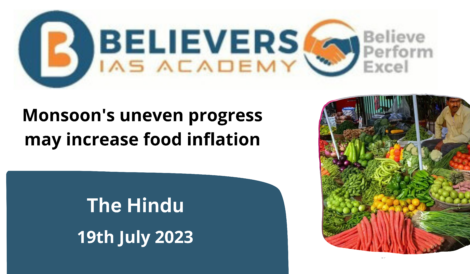Pulses prices may spiral as deficient rain mars sowing
Context
The price of tomatoes may be coming down from recent highs, but pulses could be the next victim in the fight against inflation. This is because a below-average monsoon in August reduced the area sown for pulses in the kharif season by about 10% from the previous year.
What is the crisis that India is going to face due to the Deficit rain?
- Deficient Monsoon: By 6%, India’s monsoon season fell short of its long-term average (LPA).
- Impact on Sown Area: In comparison to the previous year, the sown area for pulses during the kharif season has decreased by over 10% as a result of the insufficient monsoon.
- Pulse scarcity: Due to lesser production, the decreased seeded area raises the possibility of a pulse scarcity on the market.
- Rising Pulse Prices: Particularly for kinds like tur dal and moong dal, a decrease in pulse production may increase pulse prices.
- Inflation Pressure: Increased inflationary pressures in the economy could be brought on by the growing prices of pulses as well as current inflationary concerns.
How is it going to impact the economy?
- Inflationary Pressure: Pulses are a staple diet in many Indian homes, hence the decrease in output may result in higher costs for these foods. This may increase food prices overall, lowering consumer purchasing power and raising the cost of living.
- Household Budgets: Increasing food costs, particularly for staples like pulses, can strain household budgets and reduce consumers’ disposable income, which could have an impact on consumption patterns overall.
- Food safety: A significant source of protein and nutrients in the Indian diet is pulses. Reduced production of pulses could have an impact on food security and nutrition, especially for vulnerable people that depend significantly on these reasonably priced sources of protein.
- Expectations regarding inflation: Consumers may have increased expectations regarding inflation if staple foods like pulses continue to see persistent inflation. This may affect contract negotiations, corporate choices, or even central bank monetary policy activities.
- Consumer Sentiment: A decline in consumer confidence and sentiment may result from higher food prices. People may cut down on their spending when they are less confident in the stability of the economy, which would lower economic activity.
- Rural Income and livelihood: Income and livelihoods in rural areas are largely derived from agriculture, particularly in rural communities. Farmers’ income and livelihoods may be impacted by decreased crop yields and pricing for specific crops, which could result in financial distress.
- Rates: While tomato prices may be stabilizing following recent highs, there are worries that pulse prices, including those of tur dal and moong dal, could contribute to inflation pressures. Pulses’ pricing had increased significantly from 10.6% in June to 13.3% in July. Due to the decreased sown area brought on by insufficient rainfall, economists forecast that pulse prices would certainly increase further.
What are the reasons behind this inflation?
- Reduced Water Availability: Rainfall that is sufficient and regular is essential for delivering the water required for agricultural growth. Water shortage caused by insufficient rainfall has an impact on crop germination, growth, and general health.
- Delayed Sowing: Insufficient rainfall causes the start of the sowing season to be delayed. The delayed monsoon may present difficulties for crops whose growth and yield depend on timely seeding.
- Lower Soil Moisture: When there is not enough rain, the soil is less wet, which makes it more difficult for seeds to germinate and for young plants to develop sturdy roots.
- Impact on Pulse Cultivation: Like other crops, pulses need the right amount of water to be successfully cultivated. The inadequate monsoon is blamed for the decrease in the area seeded with pulses because farmers may decide to plant fewer pulses in favour of other crops that require less water or have a higher chance of surviving.
- Crop Failure: In extreme circumstances, where there is a protracted period of minimal rainfall, crops may fail to grow or provide noticeably decreased harvests. This might cause a production shortfall, which would raise prices.
- Economic Uncertainty: In rural areas where agriculture is a significant source of income, crop failure and lower yields can affect farmers’ livelihoods and incomes. This increases economic uncertainty.
What is the way forward?
- Infrastructure for irrigation: To lessen dependency on monsoon rainfall and maintain crop water availability, invest in enhanced irrigation infrastructure, such as drip irrigation and effective water management systems.
- Climate-Resilient Farming Practises: Promote climate-resilient farming techniques that are more suited to unpredictable rainfall patterns and severe weather events. This could involve using drought-resistant agricultural cultivars, intercropping, and crop diversification.
- Improved Seed Varieties: Develop and disseminate better seed varieties that are more robust to water scarcity and can flourish in difficult environments.
- Water Harvesting techniques: Encourage the use of water harvesting methods to collect and store rainwater for use in agriculture during dry spells.
- Rainwater Management: Implement techniques to effectively manage rainwater, such as contour bunding and groundwater recharge through rainwater collection structures.
- Crop Insurance: To protect farmers from the dangers of crop failure and income loss due to unfavourable weather conditions, crop insurance coverage should be expanded.
- Research and Innovation: Invest in research and innovation to create new agricultural techniques, crops, and technology that are suited to shifting climatic trends.





